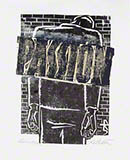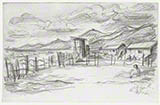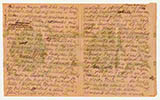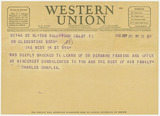Carl Rabus: Passion, linocut series (1945)
Memories of imprisonmentThe painter Carl Rabus fled from Germany in 1934 to Austria and from there to Belgium in 1938 where he was arrested in 1940 as an "enemy alien" and interned in the Saint-Cyprien camp in southern France. In 1942 he was arrested on a charge of "racial defilement" and imprisoned in Vienna.
Carl Rabus: Saint-Cyprien (1940)
The Saint-Cyprien print by the painter Carl Rabus shows a section of the beach in the southern French town Saint-Cyprien on the Mediterranean Sea. At first glance it looks like a holiday scene.
Carl Rabus: Sonett aus dem Gefängnis (Sonnet from prison - 1943)
The painter and graphic artist Carl Rabus lived from 1938 in exile in Belgium. From 1940, however, he was monitored by the Gestapo, who eventually arrested him for "racial defilement" due to his relationship with the Jewish photographer Erna Adler.
Censorship confirmation for Lisa Tetzner: Sie können nicht mehr nach Hause (You can no longer return home)
The nine-volume “children’s odyssey” Die Kinder aus Nr. 67 is today widely considered to be Lisa Tetzner’s most important work. The story takes place between 1931 and 1945 and centres around three neighbourhood children living in a tenement building who experience entirely different fates during the era of Nazi power.
Certificado de residencia para Extranjeros für Manfred Henninger (1935)
On 13 March 1935 Manfred Henninger was issued an identity document on Ibiza. Containing a photo and stamps it certified that the painter was a German citizen residing on the Spanish Mediterranean island.
Certificate of Registration von Walter Gropius (1935)
According to the Aliens Order of 1920, emigrants in the UK received a Certificate of Registration, a kind of residence permit for aliens. This had to be presented whenever holders of the permit changed their place of residence in the UK or wanted to leave the UK, whenever they went to a police station in connection with any matter relating to their registration or when a police officer or an immigration official demanded the presentation of the card.
Chanan Frenkel, blood bank in Jaffa, architectural model (1953-1956)
To ensure the supply of blood in the event of emergencies, the aid organisation Magen David Adom, founded in Tel Aviv in 1930, established the first blood bank in Palestine in 1947. For the construction of the blood bank in Jaffa the organisation commissioned architect Chanan Frenkel, who had studied at the Bauhaus in Dessau in the early 1930s.
Charlie Chaplin's telegram of condolence on the death of Richard A. Bermann (20 September 1939)
Richard A. Bermann died on September 5, 1939. Soon after his niece Clementine Bern received a telegram of condolence from Charlie Chaplin.
Chocolates Catherine, business card (c. 1944)
Erich Arendt and Katja Hayek-Arendt’s companyIn late 1943, Anna Kipper, head of the press agency Agence France-Press in Columbia’s capital Bogotá, was making preparations for a major reception. She turned to her neighbours, the German writers Erich Arendt and his wife Katja, for help.
Clément Moreau: La comedia humana/Nacht über Deutschland (1937/38), part 1 to 8
[Night over Germany] 107 Linocuts on Japanese tissue (gampi)
First published in the newspapers Argentinisches Tageblatt and Argentina Libre, 1940 Clément Moreau created his linocut cycle La comedia humana/Nacht über Deutschland [Night over Germany] in Argentina in 1937 and 1938, after fleeing Switzerland where he had lived illegally from 1933 to 1935.










![Linocut: Clément Moreau: Nacht über Deutschland [Night over Germany] Fig. 1 Linocut: Clément Moreau: Nacht über Deutschland [Night over Germany] Fig. 1](/KIE/Content/EN/Images/objects/moreau-clement-nacht-ueber-deutschland-001-en.jpg?__blob=thumbnail&v=6)
